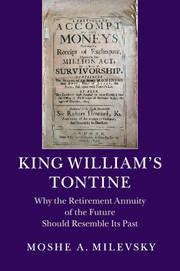Book contents
- Frontmatter
- Epigraph
- Contents
- Preface: In Memoriam for Jared
- Acknowledgments
- 1 King Billy, Protestant Hero of england
- 2 Tontine's Economic Origins: Cheaper Debt
- 3 A Most Curious Will(iam) and Older Than You Think
- 4 The Million Act to Fight a War against France
- 5 Don't Englishmen Die? Anti-Selection vs. Fraud
- 6 Is Your Tontine a Stock or a Bond?
- 7 Optimal Tontine: Hedging (Some) Longevity Risk
- 8 Conclusion: Tontines for the Twenty-First Century
- Epilogue: What Did William Really Know?
- Appendix A The List of Nominees
- Appendix B The Gompertz-Makeham Law of Mortality
- Appendix C 14% for One, 12% for Two, or 10% for Three?
- Source Notes and Guide to Further Reading
- References
- Index
Epilogue: What Did William Really Know?
Published online by Cambridge University Press: 05 May 2015
- Frontmatter
- Epigraph
- Contents
- Preface: In Memoriam for Jared
- Acknowledgments
- 1 King Billy, Protestant Hero of england
- 2 Tontine's Economic Origins: Cheaper Debt
- 3 A Most Curious Will(iam) and Older Than You Think
- 4 The Million Act to Fight a War against France
- 5 Don't Englishmen Die? Anti-Selection vs. Fraud
- 6 Is Your Tontine a Stock or a Bond?
- 7 Optimal Tontine: Hedging (Some) Longevity Risk
- 8 Conclusion: Tontines for the Twenty-First Century
- Epilogue: What Did William Really Know?
- Appendix A The List of Nominees
- Appendix B The Gompertz-Makeham Law of Mortality
- Appendix C 14% for One, 12% for Two, or 10% for Three?
- Source Notes and Guide to Further Reading
- References
- Index
Summary
It's reasonable to ask in this last section, how much King William III (equestrian statue in the below figure) really knew about the tontine launched by the English Parliament in the early part of 1693. How involved was he? Would the king of England know of such a scheme?
The Dutch King William III (1650–1702) is one of the least-known and even less appreciated English monarchs. Everyone knows about all the Georges in the seventeenth and eighteenth centuries, as well as King Henry VIII in the sixteenth century, but not much about King William III. Even the first Norman king of England (back in the eleventh century), William the Conqueror, is a better-known “historical William” and more recognized in the twenty-first century.
Although King William III reigned for almost fifteen years, and during a most critical period of English history, his name recognition is really nowhere near the Jameses, Charleses, and Georgeses. One of the leading historians of the period, Tony Claydon (2002), wrote the following in the summary to his biography: “The British never really took to William III. In his lifetime he was unpopular for his lack of sociability, for his preference for old friends from the Netherlands over Britons and for the endless drain of resources to maintain his wars” (p. 188). The expert or consensus view about King William III is that he had only two activities or preoccupations that were worthy of his time. The first was waging a lifetime war against King Louis XIV and the second was pursuing and haranguing English Parliament to get the resources for his war. Basically, he had one thing on his mind and that was to keep the money flowing.
And yet, it was precisely that drain on resources and war effort that forced Parliament to get extraordinarily creative in securing funds for their war-hungry monarch. The creativity led to the creation of the first long-term national debt, the first English tontine scheme, the Bank of England, and so on.
- Type
- Chapter
- Information
- King William's TontineWhy the Retirement Annuity of the Future Should Resemble its Past, pp. 198 - 200Publisher: Cambridge University PressPrint publication year: 2015



